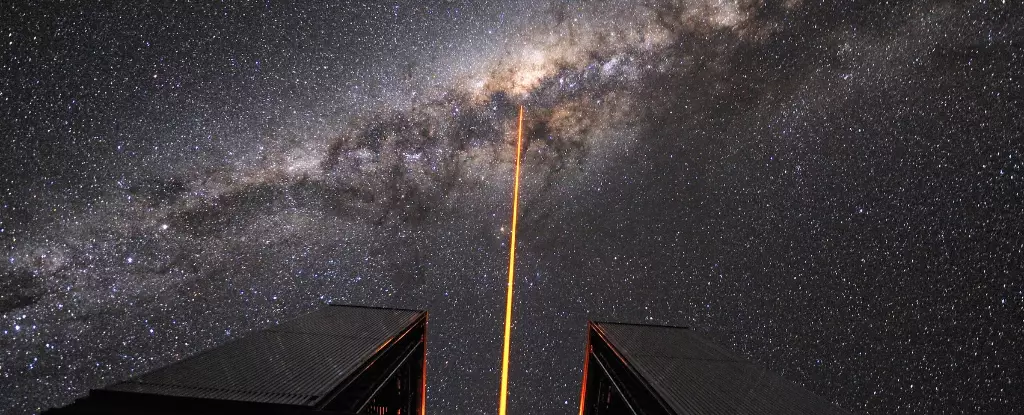At the heart of our galaxy, the Milky Way, lies an extraordinary entity known as Sagittarius A*. This supermassive black hole is an astronomical marvel, situated approximately 27,000 light years away from Earth with a staggering diameter of 23.5 million kilometers. Despite its remote location, the implications of its existence resonate throughout the cosmos, shaping the behavior of stars nearby in ways that scientists have only begun to understand. Recent advances in astronomical observation have uncovered a fascinating discovery: a binary star system that orbits around Sagittarius A*, providing critical insights into the nature of stars and their interactions with massive gravitational forces.
A binary star system consists of two stars that share an orbital relationship, circling around a common center of mass. This arrangement is not only pivotal in the study of individual star masses but also contributes significantly to our overall understanding of stellar evolution and galactic dynamics. In the Milky Way galaxy, it is estimated that about one-third of stars exist in binary or multiple systems, while the majority, including our own Sun, remain solitary. The newfound binary star system near Sagittarius A* acts as a key to unlocking the reasons behind various astrophysical phenomena, including why some stars traverse the universe at astonishing speeds.
The journey to discovering this binary system was anything but straightforward. Astronomers, led by Florian Peißker from the University of Cologne, employed the advanced capabilities of the European Southern Observatory’s Very Large Telescope (VLT). By utilizing the Doppler effect—an observable change in frequency or wavelength of light as objects in space move towards or away from us—they could detect subtle shifts in the starlight emitted by the binary system. This phenomenon revealed a peculiar “wobble” in the light patterns, suggesting that the stars were indeed in orbit around a central mass, likely the supermassive black hole itself.
The significance of this discovery lies in its rich data potential. The characteristics of the binary system offer astronomers invaluable information about star formation near black holes, leading to the conclusion that these stars are around 2.7 million years old. Interestingly, this suggests that they may not have originated within the black hole’s violent environment, but rather they have survived in its vicinity for a substantial period. This resilience indicates a fascinating dynamic between stars and the gravitational influence of black holes.
One of the most perplexing cosmic mysteries is the phenomenon of hypervelocity stars—stars that race through space at velocities exceeding 1,000 kilometers per second. While most stars maintain a relatively calm orbit around the Milky Way’s center, hypervelocity stars stand out due to their extraordinary speeds. The discovery of the binary star system may hold a crucial piece of the puzzle that connects these rapidly moving stars to their origins near supermassive black holes.
The prevailing hypothesis suggests that these hypervelocity stars were once part of a binary system that experienced encounters with Sagittarius A*. The gravitational complexities of such a system could ultimately lead to the ejection of one star, which then escapes into the galaxy at extraordinary speeds. This theory finds support in the observed trajectories of known hypervelocity stars, many of which appear to be directed away from the galactic center, validating the calculations regarding their origins.
The recent identification of a binary star system around Sagittarius A* not only enhances our understanding of stellar behaviors but also provides empirical evidence to support existing theoretical models in astrophysics. These findings highlight the intricate web of gravitational interactions that govern the dynamics of celestial bodies. As astronomers continue to investigate the relationship between black holes and the stars that orbit them, the potential for new revelations increases.
Additionally, this discovery invites a broader contemplation about the nature of our universe. The complex interactions involving stars and black holes reveal a delicate balance that fosters diverse astronomical phenomena. With every discovery like this, the cosmic narrative expands, offering glimpses into the mysteries of star formation, evolution, and the role of supermassive black holes in shaping galaxies.
As we deepen our understanding of the universe, discoveries such as the binary star system surrounding Sagittarius A* serve as important reminders of the intricate relationships that exist in the cosmos. The interplay between gravity, stellar evolution, and the enigmatic nature of black holes continues to challenge and inspire the scientific community. Each new finding not only expands the existing body of knowledge but also ignites curiosity for future exploration, ensuring that the quest for cosmic understanding remains an ever-evolving journey in the realm of astronomy.


Leave a Reply